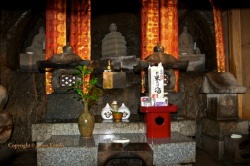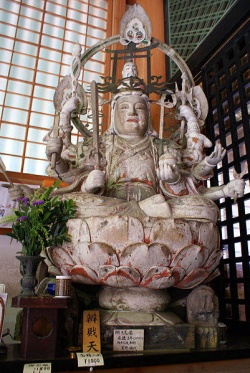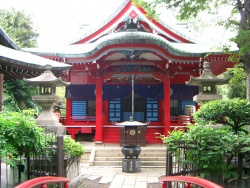Benzaiten
Benzaiten (弁才天, 弁財天) is the Japanese name for the Hindu goddess Saraswati. Worship of Benzaiten arrived in Japan during the 6th through 8th centuries, mainly via the Chinese translations of the Sutra of Golden Light, which has a section devoted to her. She is also mentioned in the Lotus Sutra and often depicted holding a biwa, a traditional Japanese lute, in contrast to Saraswati who holds a stringed instrument known as a veena. Benzaiten is a highly syncretic entity with both a Buddhist and a Shinto side.
This is Benzaiten the Buddhist god of water and by extension everything that flows: water, words, speech, eloquence, music, and knowledge (knowledge flows forth from the mind).
Benzaiten or Benten is the Japanese name for the Hindu goddess Saraswati which was adopted into Buddhism.
The god Benzaiten arrived in Japan during the 6th century via the Chinese translations of the Sutra of Golden Light.
She is mentioned also in the Lotus Sutra and is depicted holding a biwa, a traditional Japanese lute.
Benzaiten has a close association with snakes and dragons and is often shown as a human headed snake as in this temple. This is due to a passage in the Rig-Veda (6.61.7) where Sarasvati is credited with killing the three-headed snake (Vritra).
During the Shinbutsu shugõ, the fusion of Buddhism and Shintõ, the Shintõ god Ugafukijin came to be fused with the Buddhist/Hindu god Benzaiten.
Ugafukujin is the Shintõ god of agriculture and Benzaiten is the Buddhist god connected with water which is indispensable to agriculture.
Benzaiten is both a Buddhist/Hindu god and a Shintõ god in Japan. People who wish to pray for their crops can pray to Benzaiten that she may provide a bountiful harvest.
Benzaiten is also one of the seven lucky Buddhist gods - the shichifukujin - worshipped by Japanese Buddhists.
Transfer from India to Japan
Referred to as Sarasvatî Devî in Sanskrit (meaning "Goddess Saraswati"), Benzaiten is the goddess of everything that flows: water, words, speech, eloquence, music and by extension, knowledge. The original characters used to write her name read "Biancaitian" in Chinese and "Bensaiten" in Japanese (辯才天) and reflect her role as the goddess of eloquence. Because the [[Sutr] of Golden Light]] promised protection of the state, in Japan she became a protector-deity, at first of the state and then of people. Lastly, she became one of the Seven Gods of Fortune when the Sino-Japanese characters used to write her name changed to 弁財天 (Benzaiten), emphasizing her role in bestowing monetary fortune. Sometimes she is called Benten although this name usually refers to the god Brahma.
In the Rig-Veda (6.61.7) Sarasvati is credited with killing the three-headed Vritra also known as Ahi ("snake"). Vritra is also strongly associated with rivers, as is Sarasvati. This is probably one of the sources of Sarasvati/Benzaiten's close association with snakes and dragons in Japan. She is enshrined on numerous locations throughout Japan; for example, the Enoshima Island in Sagami Bay, the Chikubu Island in Lake Biwa and the Itsukushima Island in Seto Inland Sea (Japan's [[Three Great Benzaiten Shrines)]); and she and a five-headed dragon are the central figures of the Enoshima Engi, a history of the shrines on Enoshima written by the Japanese Buddhist monk Kōkei (皇慶) in AD 1047. According to Kōkei, Benzaiten is the third daughter of the dragon-king of Munetsuchi (無熱池; literally "lake without heat"), known in Sanskrit as Anavatapta, the lake lying at the center of the world according to an ancient Buddhist cosmological view.
Benzaiten as a kami
Benzaiten is a female kami to Shinto with the name Ichikishima-hime-no-mikoto (市杵島姫命?). Also, she is believed by Tendai Buddhism to be the essence of kami Ugajin, whose effigy she sometimes carries on her head together with a torii . As a consequence, she is sometimes also known as Uga (宇賀?) Benzaiten or Uga Benten. Shrine pavilions called either Benten-dō or Benten-sha (弁天社?), or even entire Shinto shrines can be dedicated to her, as in the case of Kamakura's Zeniarai Benzaiten Ugafuku Shrine or Nagoya's Kawahara Shrine.


